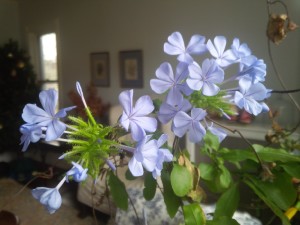I was born an optimist. I was probably born a gardener, too, though that didn’t manifest itself until after I could walk and talk. It is in my nature to look for signs of hope, especially in the natural world. Thankfully, those signs are almost always present, if you look carefully. As the New Year starts, I can’t think of a better time to catalog those harbingers of better times.
First, of course, is the gradual increase in light, now that we are on the other side of the Winter Solstice. We gain precious minutes of light each day, even if it isn’t apparent on the cloudy ones. Everyone gets at least a bit of Seasonal Affective Disorder in the winter. Now it will wane along with the darkness. That assurance should help get us all through the inevitable winter storms that tend to come in January and February.
On Christmas Eve it was so balmy outside that I went out to check the garden. It looks awful in general, due to unfinished garden clean-up and the effects of several windstorms. My goal on Christmas Eve was not to begin the much-needed tidying, but to peer under the leaves of the big Helleborus niger or “Christmas rose” in the upper back garden. I suspected that the hellebore had a holiday gift for me and I was right. Under the protective cover of the ample, palmate leaves lurked several fat white flower buds. If the weather stays mild, they should start blooming in a week to ten days, almost living up to the Christmas rose nickname. I had a strong urge to clip just one and bring it in the house to float in a little pot of water, but I stopped myself. Letting nature take its course is a good idea and the presence of those three buds gives me a good reason to check the garden ever couple of days for signs of unfurling flowers.
When I reported the Christmas rose news to my neighbor and fellow hellebore enthusiast, she started her own hunt for buds and also found a few amid the leaves. We rejoiced together in the start of the new growing season.
On the south side of the house, the giant female holly tree is having a banner year, covering itself with bright red berries. The holiday miracle is that they were not all eaten by the local bird population. My husband used to refer to the holly as the “bird condo”, because so many sparrows, cardinals and other birds nest and shelter there. This year they must be eating take-out food, leaving the uplifting sight of the berries for the sore eyes of those who pass by.
Inside the house, it is easy to get caught up in the winter despair of the many houseplants still adjusting from a long summer/fall vacation outdoors. On Christmas morning, though, I noticed that the enormous blue plumbago, which I brought in only three weeks ago, had pushed out several panicles of sky-blue blooms. Blue was my husband’s favorite color and I chose to see a message from him in the timely appearance of those blooms. Even without that association, the sight of them makes me feel infinitely more hopeful and helps me forget how much my back hurt after lugging the plumbago and its large pot into the house.
Defying their languishing neighbors, several geraniums are also blooming furiously, including a bright red one that I saved from a neighbor’s bulk pick-up pile several years ago. It looked like a wretched refugee then. Now it is a strapping specimen with blooms that shine like beacons. Like a sun-deprived human, it is putting all its energy into stretching its stalks towards the window to pull in the winter sunlight.
Each day the afternoon light illuminates the new growth on the ‘Britzensis’ willow– Salix alba subsp. vitellina ‘Britzensis’—which is vivid red in the winter. Clipped branches make an excellent addition to winter arrangements and since my willow is greatly in need of pruning, it will not miss a few. I wish I had room for a whole hedge of these gorgeous, if rambunctious trees.
People tend to look for big signs of hope. I think it is better to check for more subtle reminders—a budded branch, a single snowdrop or even a clump of onion grass, still green, stubborn and onion-y on New Year’s Eve. After all, what is more hopeful than a small flower or even a tenacious weed with the fortitude to push up from the winter-chilled earth?

